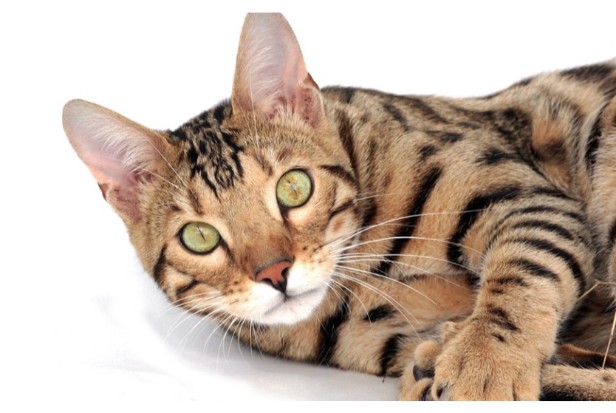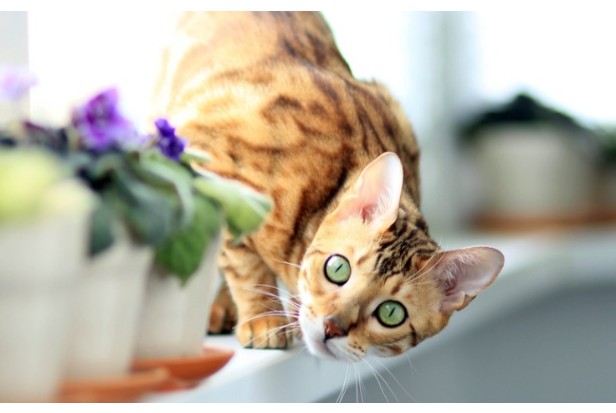When something is hypoallergenic, that means it’s relatively unlikely to cause an allergic reaction. In light of this, Bengal cats are hypoallergenic. Do not, however, assume that if you are allergic to cats you won’t experience an allergic reaction to a Bengal. Relative to other cats, Bengals may cause less of an allergic reaction.
Learn everything there is to know about cat allergies and decide whether Bengal cats are the right choice for you. Along with reducing your symptoms, you’ll learn how to manage your pet allergy.
Table of Contents
The Cause of Cat Allergies
You’re not really allergic to cat hair.
It turns out that the protein known as Fel d 1 is what’s causing your reaction. This protein is found in a cat’s saliva, urine, and dander.
While cat fur doesn’t cause allergies in and of itself, it is a key way that saliva and dander are shed throughout the environment. The protein that causes allergies is shed when cats groom themselves.
This protein is produced by ALL cats, but some people have discovered that they appear to react to certain cat breeds, including Bengals, less severely.
Why Are Bengals Less Likely to Cause Allergic Reactions Than Other Breeds?
Contrary to popular belief, cat fur is not the cause of allergic reactions. Because it is tiny, airborne, and readily accumulative on clothing and furniture, dander (dead skin) is the biggest worry for allergy sufferers.
Besides dander, other common allergy triggers are:
- Saliva
- Urine and poo
- Sweat
- Tears
- Mucous
They are all made of a substance called Fel d1, which causes allergic reactions to cats. Its lightness and stickiness enable it to linger and trigger sneezing even when your cat is not present. Bengal cats don’t fall into the category of breeds that produce little Fel d1.
Why are Bengal cats regarded as hypoallergenic? Allergic people are more likely to experience discomfort from cats that shed excessively because all the substances on the list remain on felines’ fur. Bengals have a single-layer coat and shed less, so humans living with them There is less interaction between Bengals and Fel d1.
Bengals have a short, adherent coat. They appear sleek and silky and don’t get dirty easily, which lessens the need for self-grooming. Less grooming results in less shedding, preventing Fel d1 from getting everywhere.

Signs You Might Be Allergic to Your Bengal Cat
Bengals rarely cause allergies, but if you’ve had cat allergies in the past or you’re a new parent, you should exercise caution. You should spend some time (at least 24 hours) with Bengal cats before getting one to see if you react to them.
Particularly if you have asthma or chronic bronchitis, symptoms can range from mild to extreme. Consult the following table for the most common signs of allergies:
| Mild symptoms | Extreme symptoms |
| Sneezing and a runny nose Red, watery, and itchy eyes Itchy nose and throat Cough Facial pressure Restless sleep Swollen under-eyes | Hives with swelling Difficulty breathing Chest tightness or pain Wheezing sound while exhaling Trouble sleeping due to shortness of breath, coughing or wheezing Vomiting and diarrhea Severe skin rash |
What to Do If You Have Cat Allergies & Want a Bengal
If you or a family member has cat allergies, it’s extremely important to know how you’re going to react to a Bengal before you commit to bringing one home. Bengals don’t do well when they are placed in new homes, so this should be avoided at all costs.
Therefore, try your best to become familiar with Bengals before deciding to adopt one. See how you respond after visiting a friend who owns a Bengal. Alternative: Cooperate with a Bengal breeder. Spend time with the adults and kittens during your several visits to them. Before you put down a deposit on a kitten at that particular cattery, observe how you react to the Bengals there.
Tips for the Cat-allergic Bengal Lover
There are ways to coexist if you’re determined to get a Bengal cat despite having allergies.
All cats produce saliva, urine, and dander, so you simply can’t “fix” those. However, you should be able to lessen the severity of your allergic reaction by working to reduce the spread of the protein allergen in your environment.
Here are a few tips on how to do this:
1. Feed a Species Appropriate Diet
Consider how much of an impact a healthy diet and adequate hydration have on your own skin.
With cats, the same is true. You can enhance the quality of your Bengal skin by feeding it a high-quality, species-appropriate diet. You will experience less dander, less dandruff, and fewer allergies as a result.
Diet can make a huge difference in your allergic reaction to your cat, so this should be one of the first things you address.
2. Clean, Clean, Clean
Keep an eye out for daily surface cleaning in your house. All Norwex products are recommended for this, but the dust mitt and mop stand out because cat fur sticks to the microfibers so well. Additionally, you are not using chemicals (which are frequent allergens themselves) needlessly.
Do not use carpet in your home if at all possible! In the porous, soft material, allergens settle. Hard surfaces are much simpler to keep clean.
3. Use a HEPA Air Filtration System
Due to its low weight, the Fel 1 d protein can float in the air for a very long time. To help filter the air from the protein causing your allergies, think about investing in an air purification system.
4. Limit Your Exposure to Your Bengal
Wash your hands after petting him, but avoid kissing him. Keep him out of your bedroom so you can sleep without being exposed to allergens. Ask a family member to take care of the litter box. Just make sure to tell your kitty “it’s not you, it’s me!”
5. Brush Your Bengal
Giving a Bengal a bath can be distressing for them and actually dries out their skin, increasing their dander and making the problem worse. The best option is not to bathe because doing so only temporarily reduces allergens for about 24 hours.
Instead, you can choose between two options. 1) Regular brushing will help remove loose fur; next, wipe your Bengal down with a soft, damp microfiber cloth (a simple, stress-free substitute for a full bath; it should help remove loose dander and fur and keep it from entering the environment).
The Furminator is the most efficient brush.
6. Keep the Litter Box Clean
To reduce the exposure of urine to the air, have a non-allergic family member scoop the litter box at least twice daily. You might even think about always having a small air purifier on next to the litter box.
7. Medicate Yourself
If all else fails, you could always take allergy medication for yourself. You can experiment with allergy shots, antihistamines, and decongestants based on how comfortable you are with them.
In Summary…
So, Bengal cats are hypoallergenic, right? You’ll just have to test it out for yourself, but Bengals may be considered hypoallergenic and cause less of an allergic reaction than other cats. No cat is allergen-free, though. Before deciding to buy one, please do your research.
There are lots of ways to lessen your own allergic reaction to Bengal adoption if you are determined to do so!
FAQs
8 Most Hypoallergenic Cats for People With Allergies
1 – Sphynx, the eerily unique-looking creature with no hair and no allergies.
2 – A Cornish Rex cat with a lovely tabby coat that won’t aggravate allergies.
3 – Devon Rex.
4 – Oriental.
5 – Russian Blue.
6 – Balinese.
7 – Siberian.
8 – Bengal
Do Bengal Cats Produce Dander?
To sum up, Bengals are hypoallergenic because they groom themselves less often than cats with courser coats and double coats. Bengal ownership is made possible by feeding your Bengal cat a raw diet rich in omega-3 fatty acids, which can further lessen the amount of hair and dander released into the air.
Is There a 100% Hypoallergenic Cat?
Technically, there is no such thing as a 100 percent hypoallergenic domestic cat (or dog). These breeds ought to be reasonably close if your allergy is not severe. The following is a recommendation from petMD for those who want to adopt a cat but feel their adoption options are constrained by allergies.
